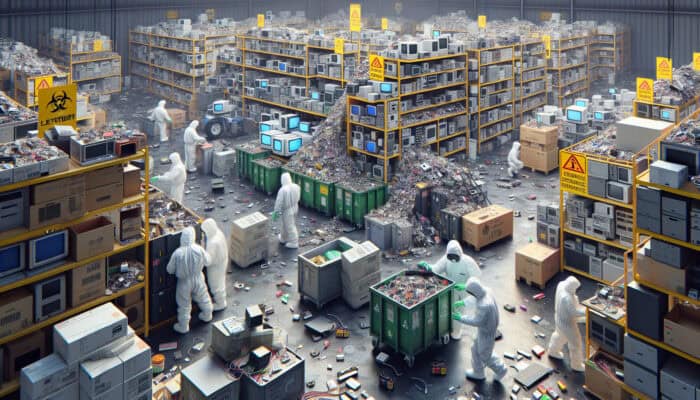Your Comprehensive Guide to Electronics Clearance: Championing Environmental Sustainability
Exploring the Concept of Electronics Clearance: A Responsible Approach

In the UK, the cost of clearing electronics encompasses the meticulous and responsible practices necessary for the recycling or disposal of electronic devices, aimed at preventing substantial environmental damage. As the quantity of electronic waste escalates, comprehending and executing effective electronics clearance has become imperative for both consumers and businesses alike. Implementing appropriate disposal techniques is crucial to avert hazardous substances, including lead and mercury, from permeating soil and water systems, ensuring public health is safeguarded. Furthermore, by adopting efficient clearance strategies, valuable materials can be recovered, which can subsequently be utilised in the production of new goods, thereby fostering a sustainable cycle of reuse that positively impacts the environment.
In recent times, the surge in consumer electronics within the UK has culminated in an overwhelming accumulation of electronic waste. As devices reach the end of their lifecycle or malfunction, many individuals find themselves uncertain about the correct disposal methods. Consequently, grasping the fundamentals of electronics clearance transcends mere compliance with regulations; it embodies a commitment to ethical alternatives that promote environmental sustainability and contribute to a healthier planet.
The Crucial Importance of Responsible Electronics Clearance for Environmental Preservation
The importance of engaging in proper electronics clearance cannot be emphasised enough. With the omnipresence of electronic devices, the proliferation of e-waste is accelerating alarmingly. If not managed adequately, improper disposal can lead to catastrophic environmental repercussions, such as the contamination of soil and water sources. Therefore, responsible clearance methodologies are essential for mitigating the ecological footprint associated with electronic waste.
Moreover, adhering to best practices in electronics disposal aligns with broader societal objectives, including fulfilling the UK's environmental targets and bolstering sustainability initiatives. By prioritising responsible electronics clearance, both individuals and organisations can effectuate a significant impact, contributing to a healthier planet while nurturing a culture of recycling and reuse. Additionally, non-compliance with clearance regulations may incur substantial fines and legal consequences, underscoring the necessity of awareness and active participation in responsible disposal initiatives.
Essential Legislation Guiding Electronics Clearance Practices in the UK
The UK has instituted a comprehensive framework of regulations governing the recycling and disposal of electronics, with the Waste Electrical and Electronic Equipment (WEEE) Directive being a pivotal piece of legislation. This directive obligates manufacturers to assume responsibility for the lifecycle management of their products, ensuring they furnish consumers with essential information regarding the responsible disposal of their electronics.
In addition to the WEEE Directive, local authorities in the UK are mandated to comply with specific guidelines concerning the collection and treatment of e-waste, ensuring local services can safely manage these items. Non-compliance with these regulations can result in severe legal ramifications for both individuals and businesses. Familiarising oneself with these regulations not only advocates for responsible disposal but also elevates public consciousness regarding environmental stewardship, which is increasingly vital among citizens in the UK.
Delving into the Financial Aspects of Electronics Clearance

Deciphering Disposal Fees for Electronic Devices
The financial implications associated with disposing of electronics can vary significantly depending on the type and size of the device in question. For smaller appliances such as toasters or kettles, disposal fees may be relatively modest, typically ranging from £5 to £15. However, larger items like televisions and refrigerators can incur considerably higher fees, often falling between £20 and £50. This disparity in disposal costs can deter many from clearing out their obsolete electronics, resulting in a rise in waste.
It is important to note that some local councils in the UK may include disposal fees within council tax or designate specific collection days for e-waste, thereby making the disposal process more accessible for residents. For businesses, the financial implications of electronics disposal can accumulate rapidly, particularly when managing larger quantities of devices. Recognising these costs is crucial for effective budgeting, as unforeseen fees may arise, especially when hazardous materials are involved.
Assessing Recycling Expenses Pertaining to Electronics
The recycling process for electronic devices often involves its own set of expenses, although certain services offer free recycling options for specific items. Numerous retailers in the UK have adopted take-back schemes, enabling consumers to return old electronics at no additional cost when purchasing a new device. This initiative not only assists consumers in decluttering their homes but also promotes responsible recycling practices that are beneficial for the environment.
Nonetheless, not every item qualifies for free recycling, and consumers might encounter fees associated with recycling certain devices. These charges can range from approximately £10 for smaller electronics to about £30 for larger items such as laptops or printers. Being cognisant of these costs allows households and businesses to better assess their options, facilitating informed decisions that take into account both budgetary constraints and environmental ramifications.
Identifying Additional Expenses Related to Electronics Clearance

During the process of clearing electronics, additional charges may arise, particularly concerning the specialised handling of hazardous materials or the disposal of large quantities of items. For instance, the disposal of items containing lithium batteries or CRT monitors generally incurs extra fees due to the specialised processes required for safe handling. Costs for such items can vary from £10 to £100, depending on the service provider and the complexities involved in the disposal process.
For businesses, these supplementary charges can become particularly pronounced, especially when disposing of outdated stock or office equipment. Adequate planning and awareness of potential extra costs can significantly influence overall clearance expenses. It is recommended for businesses to consult with professional clearance services to obtain a detailed estimate of any possible fees prior to commencing the clearance process.
The Essential Importance of Data Destruction Fees in Electronics Clearance
A critical aspect of electronics clearance is ensuring that sensitive data is securely eradicated from devices before disposal. Fees associated with data destruction can vary greatly, typically ranging from £10 to £50 per device, depending on the method employed. For example, a simple factory reset may incur lower charges, whereas more secure techniques, such as physically destroying hard drives, tend to be at the higher end of the pricing spectrum.
For businesses, investing in secure data destruction is not merely a financial consideration; it is an essential measure for safeguarding sensitive information. Various professional clearance services offer certified data destruction, ensuring that breaches of critical data are prevented. Understanding these fees is particularly vital for businesses managing confidential information, as the long-term costs associated with a data breach can far exceed the expenses linked to proper data destruction.
Effective Strategies for Streamlining Electronics Clearance
Optimising Local Council Services for Effective Electronics Disposal
A multitude of local councils across the UK have established extensive electronics clearance services designed to assist residents in responsibly disposing of their electronic waste. Often financed through council tax, these services may include scheduled collection days for e-waste or designated recycling centres where residents can conveniently drop off their outdated devices. Such initiatives not only simplify the disposal process but also significantly mitigate the environmental impact of electronic waste.
Local councils typically provide comprehensive guidelines regarding the types of electronics they accept and whether any associated fees apply. Councils may also collaborate with private recycling companies to ensure the effective processing of electronic waste. By engaging with local services, individuals contribute to a sense of community responsibility while supporting the UK‘s overarching recycling objectives, making it a practical and eco-friendly option for responsible electronics disposal.
Partnering with Private Recycling Companies for Comprehensive Solutions
While local council services offer invaluable assistance, many individuals and businesses may opt to collaborate with private recycling companies for their electronics clearance needs. These firms frequently provide a complete suite of services, including collection, recycling, and data destruction. Although typically more costly than council services, private recycling companies may offer enhanced convenience and specialised expertise, particularly for businesses managing substantial volumes of electronic waste.
Private companies often emphasise their commitment to environmentally responsible practices, ensuring that all materials are recycled in a sustainable manner. This transparency is particularly attractive to businesses striving to enhance their sustainability credentials. Moreover, many of these companies can tailor their services to meet specific requirements, providing bulk clearance options or managed services that streamline the disposal process while ensuring compliance with relevant regulations.
Investigating DIY Clearance Options for Cost Savings
For those seeking to minimise expenses related to electronics clearance, DIY options can present a viable alternative. Numerous designated recycling centres throughout the UK permit individuals to drop off their old electronics for free or at a minimal cost. By researching local options, individuals can uncover various opportunities for responsible disposal without incurring substantial financial burdens.
When considering DIY options, it is crucial to ensure that the recycling centres are certified and comply with environmental regulations. Additionally, individuals should assess the types of electronics they wish to dispose of, as certain items may necessitate special handling. Although DIY clearance may require additional effort, it empowers individuals to actively contribute to environmental sustainability while simultaneously saving money.
Assessing the Environmental Implications of Electronics Clearance
Strategies to Reduce Electronic Waste Through Responsible Practices
The escalating volume of electronic waste presents a considerable environmental challenge, particularly in the UK's urban areas. Effective electronics clearance is vital for diminishing this waste by ensuring that devices are recycled or disposed of safely and responsibly. By engaging in responsible disposal practices, both individuals and businesses can collectively reduce the amount of e-waste that ultimately ends up in landfills, where it can persist for years, leaching harmful substances into the environment.
Recycling electronics not only alleviates waste but also conserves precious natural resources. Valuable materials such as gold, silver, and rare earth metals can be extracted from obsolete devices, which helps decrease the demand for new raw materials. This process is vital for fostering a circular economy, where resources are reused and recycled, yielding significant environmental advantages and advancing sustainability.
Protecting Natural Ecosystems from the Hazards of Electronic Waste
In the UK, the careless disposal of electronics can lead to dire consequences for natural ecosystems. Toxic substances found in electronic devices, such as lead and cadmium, can seep into the soil and waterways, resulting in the pollution of ecosystems. This poses a substantial threat to both wildlife and plant life, disrupting the delicate balance of natural habitats.
By prioritising responsible electronics clearance, individuals and organisations can significantly contribute to the protection of these crucial ecosystems. Promoting a culture of sustainability not only preserves the environment but also safeguards biodiversity. The collective commitment to clearing electronics responsibly will leave a lasting positive legacy on the UK’s natural landscapes, ensuring that future generations can enjoy a vibrant and healthy environment.
Advancing Sustainability Through Proactive Electronics Clearance Practices
In an era when sustainability dominates public discourse, responsible electronics clearance has emerged as a vital aspect of eco-friendly practices. By engaging in the proper disposal and recycling of electronic devices, consumers actively partake in broader sustainability initiatives within the UK. This not only enhances the credibility of individuals and organisations but also fosters a culture centred on responsible consumption and waste management.
Communities that adopt sustainable electronics clearance methods can inspire others to follow suit, creating a ripple effect that encourages more individuals to consider their environmental impact. This collective movement supports the UK‘s goals of reducing carbon emissions and conserving resources, positioning the nation as a frontrunner in sustainability efforts.
Lowering Carbon Footprint Through Effective Electronics Clearance Techniques
Responsible electronics clearance plays a pivotal role in reducing the carbon footprint associated with the production and disposal of electronic devices. By recycling electronics appropriately, the demand for new materials diminishes, resulting in lower greenhouse gas emissions linked to extraction and production processes. This is particularly pertinent given the UK’s commitment to achieving net-zero carbon emissions by 2050.
By choosing responsible electronics clearance, both individuals and businesses can actively combat climate change. This demonstrates a commitment to environmental accountability, aligning with the UK’s long-term sustainability objectives and contributing to a healthier planet for all.
Encouraging Recycling Initiatives for a Sustainable Future
The process of clearing electronics bolsters recycling initiatives that advocate for a circular economy, significantly reducing the demand for raw materials in the UK. By responsibly disposing of outdated devices, individuals contribute to a system where materials are reused, recycled, and reintegrated into the production cycle. This not only minimises waste but also conserves resources and mitigates environmental contamination.
Furthermore, promoting recycling initiatives raises awareness regarding the environmental consequences of electronic waste. Educational campaigns and community programmes centred on responsible electronics clearance can empower individuals to make informed decisions regarding their electronic devices, leading to a broader cultural shift towards sustainability.
Examining Financial Support and Incentives for Electronics Clearance
Government Grants and Programmes Supporting Electronics Clearance Initiatives
The UK government offers a variety of grants and programmes designed to assist both individuals and businesses with their electronic waste clearance efforts. These initiatives aim to encourage responsible disposal and recycling practices while alleviating the financial burden associated with electronic waste clearance. For instance, some local councils may provide funding for businesses implementing sustainable waste management strategies, including the recycling of electronics.
Additionally, numerous non-profit organisations offer resources and support to help individuals and businesses navigate the complexities of electronics clearance, often providing guidance on available grants. Awareness of these opportunities can lead to significant cost savings for those committed to responsible electronics disposal.
Identifying Tax Benefits for Businesses Engaged in Electronics Clearance
For businesses investing in sustainable electronics clearance practices, potential tax advantages may be available. The UK government has introduced tax incentives to promote environmentally responsible business practices, including waste management and recycling efforts. By accurately documenting expenses related to electronics clearance, businesses may qualify for tax deductions, thereby enhancing their overall financial health.
Understanding these tax benefits is essential for businesses looking to invest in sustainable practices. By integrating electronics clearance into their operational strategies, companies can contribute to environmental sustainability while simultaneously improving their fiscal viability.
Effective Cost-Saving Strategies for Electronics Clearance
Individuals and businesses aiming to reduce costs associated with electronics clearance can implement several effective cost-saving strategies. One practical approach is to engage in bulk clearance—consolidating multiple devices for disposal can often lead to reduced fees per item. Additionally, researching local council services may uncover free or low-cost disposal options, allowing residents to declutter their electronics without incurring significant expenses.
Another valuable tactic is to explore take-back schemes offered by numerous retailers, which allow consumers to trade in old devices when purchasing new ones, typically without incurring extra charges. By considering various options and planning ahead, individuals and businesses can realise considerable savings while responsibly disposing of their electronics.
Assessing Best Practices and Success Stories in Electronics Clearance
Highlighting Successful Electronics Clearance Initiatives
The UK has witnessed numerous successful electronics clearance initiatives that showcase effective and environmentally sound methodologies. For example, various local councils have launched community-wide initiatives that encourage residents to participate in regular e-waste collection days. These projects not only facilitate responsible disposal but also promote community engagement and awareness about the challenges posed by electronic waste.
Moreover, several businesses have implemented comprehensive electronics clearance strategies that seamlessly integrate recycling practices into their operations. These initiatives not only minimise waste but also promote sustainability, leading to long-term financial advantages. Successful case studies provide valuable insights for others aspiring to adopt similar practices, illustrating the potential benefits of responsible electronics clearance.
Learning from Previous Electronics Clearance Efforts
Evaluating past electronics clearance efforts yields essential lessons that can guide future practices. A common takeaway is the necessity for clear communication and education regarding electronics disposal options. Many individuals remain unaware of the services and regulations available to them, often resulting in improper disposal. Enhanced public awareness campaigns can significantly elevate participation rates in recycling programmes.
Furthermore, businesses must learn to anticipate potential challenges, such as unexpected fees or compliance issues. By proactively addressing these concerns and seeking expert guidance, organisations can refine their electronics clearance strategies, minimise costs, and ultimately achieve more effective waste management practices.
Implementing Best Practices for Cost Management in Electronics Clearance
Organisations can adopt several best practices for efficiently managing the costs associated with electronics clearance. Strategic planning is crucial—establishing a clear budget and timeline for clearance projects can help mitigate the risk of unforeseen expenses. Furthermore, involving stakeholders early in the process can enhance logistics, ensuring that all facets of clearance are thoroughly evaluated.
Choosing the right service providers is another critical aspect of cost management. Researching different options and comparing services empowers organisations to make informed decisions, identifying the most cost-effective and environmentally responsible choices. By implementing these best practices, individuals and businesses can achieve an efficient electronics clearance process while minimising their expenditures.
Ensuring Compliance with Electronics Clearance Regulations
Navigating the intricate array of regulations governing electronics clearance in the UK can be daunting; however, adherence to these guidelines is essential for avoiding penalties and fostering sustainable practices. Familiarising oneself with the WEEE Directive and local council regulations is an essential first step.
Organisations should meticulously document their clearance practices to ensure compliance with all relevant laws and regulations. Collaborating with professional clearance services can provide additional assurance, as these experts possess extensive knowledge of current regulations and best practices. By prioritising regulatory compliance, individuals and businesses can strengthen their sustainability efforts while minimising the risk of legal repercussions.
Responding to Common Inquiries Regarding Electronics Clearance
What does electronics clearance entail?
Electronics clearance involves the responsible disposal or recycling of electronic devices to mitigate environmental damage and ensure compliance with regulations.
Why is proper electronics clearance essential?
Proper electronics clearance reduces e-waste, protects the environment, and ensures compliance with UK regulations, thereby preventing pollution and conserving valuable resources.
What are the costs involved in electronics clearance?
Costs can fluctuate significantly based on the type and size of the device, ranging from disposal fees to recycling costs, which may also encompass additional charges for hazardous materials.
What local services are available for electronics clearance?
Many local councils in the UK provide electronics clearance services, often included in council tax, offering scheduled collections or dedicated recycling centres for residents.
How can individuals pursue DIY electronics clearance?
Individuals can opt for DIY clearance by locating designated recycling centres that accept electronics, often at little or no cost.
What is the environmental impact of electronics clearance?
Responsible clearance diminishes electronic waste, protects natural habitats, promotes sustainability, and aids in minimising the carbon footprint linked to electronics.
Are there financial incentives for engaging in electronics clearance?
Yes, the UK government provides grants and tax benefits to encourage sustainable electronics clearance efforts for both individuals and businesses.
What best practices can assist in managing clearance costs?
Effective planning, stakeholder involvement, and selecting appropriate service providers are vital for efficiently controlling costs related to electronics clearance.
How can businesses ensure adherence to regulations?
Businesses should familiarise themselves with relevant regulations, document their clearance practices, and consider partnering with professional services for expert guidance.
What insights can be gleaned from previous electronics clearance initiatives?
Key insights underscore the importance of public awareness, clear communication regarding disposal options, and anticipating challenges related to fees and compliance.
Join the Conversation on Facebook!
The Article: Cost of Clearing Electronics in the UK: A Comprehensive Guide Was First Found At https://birminghamhouseclearance.com
The Article Cost of Clearing Electronics in the UK Explained Was Found On https://limitsofstrategy.com

